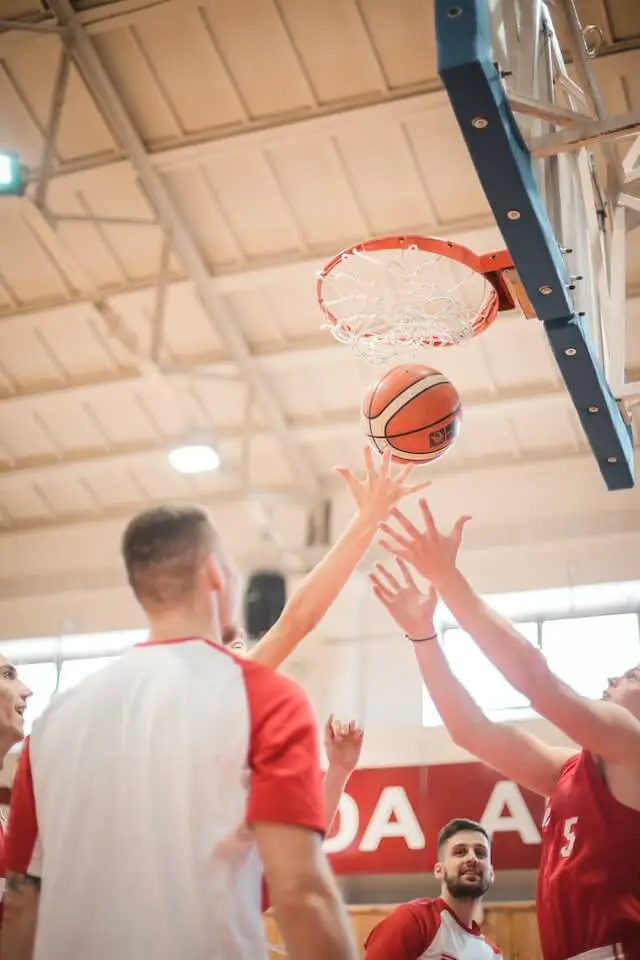Last Updated April 22, 2024 Last Updated October 11, 2023 by Edward Pullen
Basketball more than just a sport, is a dynamic and fast-paced game where every move counts. And behind the scenes, orchestrating the magic on the court, are the unsung heroes of the game – the coaches. The role of a basketball coach extends far beyond strategizing plays; it encompasses mentorship, leadership, and the art of honing raw talent into a formidable team.
In the world of basketball, coaching is the linchpin that can transform a group of individuals into a cohesive unit capable of achieving greatness. A coach’s influence can be the difference between victory and defeat, and they can nurture, train, and inspire which makes them an integral part of a team’s success.
Table of Content
- The Role of Effective Coaching
- The Power of Visual Communication
- How to Utilize Whiteboard Tools in Basketball Coaching?
- Offensive Strategies
- Defensive Strategies
- In-Game Adjustments
- The Importance of Adaptability in Coaching
- Making In-Game Adjustments
- Player Development Strategies
- Team-Building and Motivation
- Motivational Techniques
- Conclusion
The Role of Effective Coaching
Effective coaching is the backbone of success in basketball, and it encompasses a wide array of roles and responsibilities that extend far beyond the boundaries of the court. A skilled basketball coach is not merely a spectator or a strategist; they are mentors, motivators, and leaders who mold athletes into champions. In this section, we will dissect the multifaceted role of a basketball coach, shedding light on their indispensable contributions to the sport.
Player Development
At the heart of a coach’s mission lies the drive to get better at basketball through player development. Coaches are tasked with identifying and nurturing raw talent, refining skills, and transforming athletes into well-rounded players. This process involves assessing the strengths and weaknesses of each player, devising personalized training regimens, and constantly pushing individuals to reach their full potential.
Coaches serve as educators, imparting fundamental basketball skills such as shooting, dribbling, passing, and defensive techniques. Beyond the physical aspects, they instill discipline, teamwork, and a deep understanding of the game’s nuances in their players. The goal is to create athletes who are formidable on the court and well-prepared for life beyond basketball.
Strategy and Game Planning
A basketball game is not won by chance but through meticulous planning and execution. Coaches are the architects of strategy, responsible for crafting offensive and defensive game plans tailored to their team’s strengths and weaknesses. They analyze opponents, study game footage, and strategize plays that exploit vulnerabilities and capitalize on strengths.
During games, coaches make split-second decisions, call timeouts, and guide players on the court. They adjust strategies on the fly, adapting to the game’s ever-changing dynamics. A coach’s ability to read the game’s flow and make astute decisions is often the difference between victory and defeat.
The Power of Visual Communication
In basketball coaching, effective communication is the cornerstone of success. The ability to convey ideas, strategies, and concepts to players clearly and concisely can be the difference between a well-executed play and a missed opportunity. Visual aids play a pivotal role in enhancing this communication process, and in the digital age, online whiteboard tools have become indispensable assets for coaches.
The Importance of Visual Aids
Why are visual aids so crucial in coaching? The answer lies in our fundamental way of processing information. Humans are inherently visual creatures, and our brains are wired to process visual information more rapidly and effectively than text or spoken words alone. In a basketball game or practice environment, coaches often need to convey complex ideas swiftly, and visual aids provide a means to do just that.
One of the most powerful tools in a coach’s arsenal is the whiteboard – a blank canvas where strategies come to life. Traditional whiteboards have long been a staple in locker rooms and practice facilities, but in today’s digital landscape, online whiteboard tools like Miro have taken center stage. These platforms allow coaches to illustrate plays, diagram strategies, and break down drills with precision and ease.
How to Utilize Whiteboard Tools in Basketball Coaching?
As we’ve established the significance of online whiteboard tools like Miro in basketball coaching, it’s essential to understand how coaches can effectively utilize these tools to enhance their coaching methodologies. In this section, we’ll provide practical examples of how coaches can harness the capabilities of whiteboard tools for various aspects of coaching.
Drawing up Offensive and Defensive Plays:
Online whiteboard tools allow coaches to diagram plays with precision and clarity. Coaches can create intricate offensive and defensive schemes, illustrating player positions, movements, and responsibilities. For example, a coach can:
Design offensive plays:
Create visual representations of set plays, including pick-and-rolls, isolation plays, and fast-break strategies.
Develop defensive strategies:
Diagram defensive schemes such as zone defenses, full-court presses, and trapping defenses to demonstrate player assignments and rotations.
Analyzing Player Movements and Positioning:
Effective player analysis is a cornerstone of coaching. Whiteboard tools facilitate this by allowing coaches to dissect game footage, pinpoint player movements, and assess positioning. Coaches can:
Break down game footage:
Import video clips into the whiteboard tool to analyze specific sequences, such as a player’s positioning during a fast break.
Simplifying Complex Concepts
Basketball is a game of intricate strategies, and players must understand the plays, positions, and movements involved. Visual aids make this comprehension more accessible. Whether it’s illustrating the path of a ball during a play, demonstrating defensive rotations, or designing new drills, the visual representation of these concepts simplifies the learning process. Players can see, in real-time, how the puzzle pieces fit together, making it easier to execute on the court.
Moreover, visual aids transcend language barriers, making them particularly useful in diverse teams where players may come from different backgrounds and speak different languages. A well-drawn play or diagram speaks a universal language that everyone can understand.
Offensive Strategies
In the heart of every basketball game lies the relentless pursuit of scoring points, and this quest is fueled by a myriad of offensive strategies. Coaches draw from a playbook filled with diverse tactics to gain a competitive edge. In this section, we will explore a range of offensive strategies that form the foundation of a team’s scoring prowess:
Fast Break Offense
The fast-break offense is the embodiment of speed and transition play in basketball. Coaches employ this strategy to capitalize on moments of opportunity immediately after gaining possession of the ball. It’s a high-paced approach where players push the ball up the court with haste, aiming to catch the opposing defense off-guard. The fast break thrives on quick decision-making, coordinated teamwork, and exploiting the slightest defensive lapse.
Half-Court Offense
In stark contrast to the frenetic pace of fast breaks, half-court offense is a systematic approach that thrives in controlled settings. Coaches use this strategy when the game slows down, often against formidable defenses or in crucial late-game situations. It revolves around ball movement, precise execution of set plays, and creating opportunities through clever screens and off-the-ball movement.
Motion Offense
Motion offense is a dynamic strategy that values constant player movement, intelligent reads, and adaptability. Rather than relying on scripted plays, this approach empowers players to make decisions based on the defense’s reactions. It’s an offense that thrives on spacing, timing, and the collective basketball IQ of the team. Coaches use motion offense to create unpredictability and exploit defensive weaknesses.
Pick-and-Roll Plays
Pick-and-roll plays are staples in many coaches’ arsenals. This tactic leverages the synergy between a ball handler and a screen-setting teammate. The ball handler uses the screen to create separation from their defender, putting pressure on the defense to make quick decisions. Coaches design pick-and-roll plays to create scoring opportunities, either for the ball handler’s shot or by creating mismatches in defensive coverage.
Isolation Plays
Isolation plays are a strategic choice to maximize the talents of a standout player, often the team’s star. Coaches isolate their key players in a one-on-one matchup, allowing them to showcase their skills and create scoring opportunities. These plays are designed to exploit a player’s strengths and exploit defensive weaknesses, making them an effective tool in the coach’s toolbox.
In the following sections, we will delve deeper into these offensive strategies, unraveling their intricacies and exploring how coaches implement them to outmaneuver opponents, maximize scoring opportunities, and achieve victory on the basketball court.
Defensive Strategies
Defense is the cornerstone of success in basketball, and coaches employ a variety of strategic approaches to disrupt their opponents’ plays and limit scoring opportunities. In this section, we will explore a range of defensive strategies coaches use, and elucidate how these strategies can effectively disrupt opponents and keep their scoring in check.
Man-to-Man Defense
Man-to-man defense is a fundamental strategy in basketball, where each defender guards a specific opponent. In this strategy, defenders closely mark their assigned opponents, denying them open shots, disrupting passes, and contesting every move. Coaches teach techniques for on-ball defense, help defense, and defensive rotations to prevent easy baskets. Man-to-man defense isolates opponents, forces contested shots, and disrupts offensive plays.
Zone Defense
Zone defense is a tactical approach where defenders protect specific areas on the court rather than guarding individual players. Coaches employ this strategy to clog passing lanes, contest shots, and create turnovers. Zone defenses, such as the 2-3 zone or 1-3-1 zone, are effective at confusing opponents, limiting driving lanes, and forcing outside shots. By working collectively as a unit, defenders aim to disrupt the flow of the opponent’s offense.
Full-Court Press
The full-court press is an aggressive defensive strategy that applies relentless pressure on opponents when they inbound the ball. Defenders engage the opposing players at their end of the court, denying them time and space to initiate their offense. The goal is to disrupt the opponent’s offensive rhythm, create turnovers, and force hurried decisions. A well-executed full-court press can lead to steals, fast-break opportunities, and mental fatigue for the opposing team.
Trap Defense
Trap defense involves converging multiple defenders on the ball handler, often in a corner or along the sideline. Coaches use trap defenses to trap the ball handler, double-team them, and force them into difficult passing situations. This strategy disrupts opponents’ ball movement, creates turnovers, and often leads to fast-break opportunities. Trap defenses are particularly effective when executed with precision and timing.
When employed with precision and teamwork, these defensive strategies can disrupt opponents’ plays, limit scoring options, and apply intense pressure. Coaches carefully select and adapt these strategies based on the strengths and weaknesses of both their own team and their opponents, striving to gain a competitive edge on the basketball court.
In-Game Adjustments
Basketball is a dynamic sport, where the ebb and flow of a game can change in the blink of an eye. Coaches must be keen to adapt and recalibrate their strategies on the fly. In this section, we shed light on the importance of adaptability in coaching, how coaches make critical in-game adjustments based on many factors, and provide noteworthy examples of famous coaches who have demonstrated their strategic prowess in the heat of battle.
The Importance of Adaptability in Coaching
Adaptability stands as a cornerstone of successful coaching. Basketball games are unpredictable, and the ability to pivot swiftly in response to changing circumstances is what distinguishes a great coach. Adaptability entails acknowledging that a plan may require adjustments and possessing the astute foresight to know when and how to make those changes. Coaches who embrace adaptability instill confidence in their players, creating an environment where every challenge becomes an opportunity for growth and triumph.
Making In-Game Adjustments
Coaches are, in essence, strategists who meticulously analyze the game’s dynamics as they unfold. They closely monitor opponent actions, scrutinize player performance, and meticulously calculate the score’s impact on the game’s trajectory. In-game adjustments can be wide-ranging, from tweaking offensive plays to altering defensive schemes or fine-tuning player rotations. Coaches are known to utilize timeouts, huddles, and sideline communication to convey these adjustments to their teams.
Player Development Strategies
Basketball coaching is a multifaceted endeavor that extends beyond the Xs and Os of game strategy. It encompasses the holistic development of individual players, nurturing their skills and potential to thrive on the court. In this section, we explore the role of coaching in player development, delve into strategies for enhancing specific skills, and underline the pivotal role coaches play in harnessing and maximizing player potential.
Coaching’s Role in Player Development
Coaching is a dynamic relationship between mentors and players, where the growth and refinement of skills are paramount. It extends to player development, guiding athletes on their journeys to becoming better basketball players and well-rounded individuals. Coaches serve as educators, motivators, and mentors, imparting not only the technical aspects of the game but also essential life skills such as discipline, teamwork, and perseverance. This mentorship extends to instilling a growth mindset, encouraging players to embrace challenges, learn from failures, and continuously strive for improvement.
Strategies for Improving Individual Player Skills
Individual player skills are the building blocks of a successful basketball team. Coaches employ various strategies to enhance these skills, catering to each player’s unique needs and strengths. Delighting, ball-handling, and defense skills are honed through deliberate practice and targeted drills. Shooting techniques are refined through repetition, focusing on accuracy, range, and consistency. Ball-handling skills, including dribbling and passing, are developed through drills emphasizing control and decision-making.
Defensive abilities are cultivated by teaching players to anticipate opponents’ moves contest shots, and create turnovers. These strategies are integral to player development, ensuring each athlete reaches their full potential.
Emphasizing Coaches’ Role in Nurturing Talent
Coaches are not merely instructors but also talent nurturers. They assess players’ strengths and weaknesses, crafting personalized development plans tailored to each individual. Coaches provide constructive feedback, set realistic goals, and challenge players to reach new heights.
Beyond technical skills, coaches foster mental resilience, teaching players to handle pressure, stay focused, and adapt to game situations. The mentorship aspect of coaching extends to building players’ confidence, nurturing their self-belief, and helping them discover their unique talents. Through their guidance, coaches unlock the latent potential within players, creating an environment where growth is encouraged and expected.
In the dynamic world of basketball, player development is the foundation upon which successful teams are built. In their multifaceted roles, coaches craft game strategies and mold individuals into skilled athletes and exemplary human beings.
By embracing tailored strategies and fostering a growth-oriented environment, coaches empower players to realize their full potential, elevating not only individual skills but also the team’s overall performance.
Team-Building and Motivation
In basketball, success often hinges on the intangible elements of team chemistry and unwavering motivation. This section dives into strategies coaches employ to foster team cohesion and inspire players to give their utmost effort. We will also share anecdotes illustrating the successful implementation of these strategies.
Strategies for Building Team Chemistry and Cohesion
Team chemistry is the invisible thread that binds players together, fostering trust and understanding on and off the court. Coaches employ various strategies to nurture this chemistry:
- Team Bonding Activities: Organizing team-building activities outside of basketball that encourage camaraderie and trust.
- Effective Communication: Emphasizing open and honest communication to resolve conflicts and build strong interpersonal relationships.
- Shared Goals and Values: Aligning the team around common goals and values, ensuring unity of purpose.
- Clear Roles and Expectations: Defining player roles and expectations, reducing uncertainty, and fostering unity.
Motivational Techniques
Motivation is the engine that drives peak performance in basketball. Coaches employ motivational techniques to inspire players to give their best effort:
- Positive Reinforcement: Using praise and recognition to boost players’ confidence and morale.
- Setting Challenges: Challenging players by setting ambitious goals and emphasizing growth as the ultimate reward.
- Inspiring Speeches: Delivering motivating speeches before games or during critical moments to ignite players’ passion and determination.
- Leading by Example: Coaches serve as role models, embodying the work ethic and commitment they expect from their players.
Conclusion
In basketball’s dynamic world, coaching strategies are the guiding light that leads teams toward victory. They encompass offense, defense, player development, adaptability, and the delicate art of team-building and motivation. As we conclude this exploration, we must emphasize the critical role of coaching strategies in achieving success on the hardwood.
Coaches, take heed: basketball is ever-evolving, and success demands continuous refinement and adaptation of your strategies. In the face of shifting dynamics and challenges, you can adapt and innovate which will propel your team to new heights.
Never underestimate the enduring impact that effective coaching strategies can have on a team’s performance and ultimate success. They are the bedrock upon which championships are built, the compass that guides players through adversity, and the force that transforms a group of individuals into a formidable team. The journey of basketball is never-ending, and the brilliance of your coaching strategies eternally illuminates the path to success.
- How To Make Basketball Shoes More Grippy? - October 12, 2023
- How to Become a Basketball Referee? - October 11, 2023
- Unlocking Basketball Success: The Art of Effective Coaching Strategies - October 10, 2023





